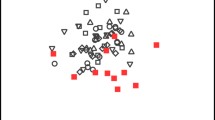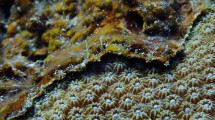Abstract
Competition for space changes species’ distributions and community organization on tropical rocky shores, and the presence of secondary metabolites in the tissues of non-indigenous species may aid them in establishing and expanding their range through negative competitive interactions. The aim of this study was to describe the range of chemical substances produced by the non-indigenous cup corals Tubastraea coccinea and T. tagusensis and to test whether they varied in the field when the corals were placed in proximity to two local competitors. Cholest-5-en-3β-ol and 9-octadecanoic acid were two common secondary metabolites found in the tissues of Tubastraea. In the competition interaction experiment, necrosis was detected on the tissues of the coral Mussismilia hispida, and this species induced variation in sterol, alkaloid, and fatty acid production in Tubastraea tissues. In contrast, a sponge overgrew Tubastraea colonies. These results indicate that chemical defense may contribute to the ability of these non-indigenous corals to invade native communities.





Similar content being viewed by others
References
Aerts LAM, van Soest RWM (1997) Quantification of sponges/coral interactions in a physically stressed reef community, NE Colombia. Mar Ecol Prog Ser 148:125–134
Becerro MA, Paul VJ, Starmer J (1998) Intracolonial variation in chemical defenses of the sponge Cacospongia sp. and its consequences on generalist fish predators and the specialist nudibranch Glossodoris pallida. Mar Ecol Prog Ser 168:187–196
Brusca RC, Brusca GJ (2003) Invertebrates. Sinauer Associates, Inc., Sunderland
Budzikiewicz H, Djerassi C, Williams DH (1964) Interpretation of mass spectra of compounds. Holden-Day, San Francisco
Chiang IZ, Huang WY, Wu JT (2004) Allelochemicals of Botryococcus braunii (Chlorophyceae). J Phycol 40:474–480
Coll JC (1992) The chemistry and chemical ecology of octocorals (Coelenterata, Anthozoa, Octocorallia). Chem Rev 92:613–631
Coll JC, Sammarco PW (1983) Terpenoid toxins of soft corals (Cnidaria, Octocoralllia): their nature, toxicity, and ecological significance. Toxicon 3:69–72
Creed JC (2006) Two invasive alien azooxanthellate corals, Tubastraea coccinea and Tubastraea tagusensis, dominate the native zooxanthellate Mussismilia hispida in Brazil. Coral Reefs 25:350
Davies PS (1991) Effect of daylight variation on the energy budgets of shallow-water corals. Mar Biol 108:137–144
De Paula AF (2007) Biologia reprodutiva, crescimento e competição dos corais invasores Tubastraea coccinea e Tubastraea tagusensis (Scleractinia: Dendrophylliidae) com espécies nativas. Dissertation, Federal University of Rio de Janeiro
De Paula AF, Creed JC (2004) Two species of the coral Tubastraea (Cnidaria, Scleractinia) in Brazil: a case of accidental introduction. Bull Mar Sci 74:175–183
De Paula AF, Creed JC (2005) Spatial distribution and abundance of nonindigenous coral genus Tubastraea (Cnidaria, Scleractinia) around Ilha Grande, Brazil. Braz J Biol 65:661–673
Dworjanyn S, De Nys R, Steinberg PD (1999) Localization of secondary metabolites in the red alga Delisea pulchra. Mar Biol 133:727–736
Epifanio RA, Maia LF, Pawlik JR, Fenical W (2007) Antipredatory secosterols from the octocoral Pseudopterogorgia americana. Mar Ecol Prog Ser 329:307–310
Fleury BG, Coll JC, Sammarco PW, Tentori E, Duquesne S (2004) Complementary (secondary) metabolites in an octocoral competing with a scleractinian coral: effects of varying nutrient regimes. J Exp Mar Biol Ecol 303:115–131
Fleury BG, Lages BG, Barbosa JP, Kaiser CR, Pinto AC (2008) New hemiketal steroid from the introduced soft coral Chromonephthea braziliensis is a chemical defense against predatory fishes. J Chem Ecol 34:1–5
Glynn PW, Colley SB, Maté JL, Cotés J, Guzman HM, Bailey RL, Feingold JS, Enochs IC (2007) Reproductive ecology of the azooxanthelate coral Tubastraea coccinea in the Equatorial Eastern Pacific: part V. Dendrophylliidae. Mar Biol 153:529–544
Harland AD, Spencer Davies P, Fixter LM (1992) Lipid content of some Caribbean corals in relation to depth and light. Mar Biol 113:357–361
Harvell CD, Fenical W (1989) Chemical and structural defenses of Caribbean gorgonians (Pseudopterogorgia spp.): intracolony localization of defense. Limnol Oceanogr 34:382–389
Harvell CD, Fenical W, Roussis V, Ruesink JL, Griggs CC, Greene CH (1993) Local and geographic variation in the defensive chemistry of a West Indian gorgonian coral (Briaerum asbestinum). Mar Ecol Prog Ser 93:165–173
Hay ME, Duffy JE, Fenical W, Gustafson K (1988) Chemical defense in the seaweed Dictyopteris delicatula: differential effects against reef fishes and amphipods. Mar Ecol Prog Ser 48:185–192
Hill M (1998) Spongivory on Caribbean reefs releases corals from competition with sponges. Oecologia 117:143–150
Kakisawa H, Asari F, Kusumi T, Toma T, Sakurai T, Oohusa T, Hara Y, Chihara M (1988) An allelopathic fatty acid from the brown alga Cladosiphon okamuranus. Phytochemistry 27:731–735
Kelman D, Benayahu Y, Kashman Y (2000) Variation in secondary metabolite concentrations in yellow and grey morphs of the Red Sea soft coral Parerythropodium fulvum fulvum: possible ecological implications. J Chem Ecol 26:1123–1133
Kelman D, Kashman Y, Hill R, Rosenberg E, Loya Y (2009) Chemical warfare in the sea. The search for antibiotics from Red Sea corals and sponges. Pure Appl Chem 81:1113–1121
Kim K, Lasker HR (1997) Flow-mediated resource competition in the suspension feeding gorgonian Plexaura homomalla (Esper). J Exp Mar Biol Ecol 215:49–64
Koh EGL (1997) Do scleractinian corals engage in chemical warfare against microbes? J Chem Ecol 23:379–398
Koh EGL, Sweatman H (2000) Chemical warfare among scleractinians: bioactive natural products from Tubastraea falkneri Wells kill larvae of potential competitors. J Exp Mar Biol Ecol 251:141–160
Lages BG, Fleury BG, Ferreira CEL, Pereira RC (2006) Chemical defense of an exotic coral as invasion strategy. J Exp Mar Biol Ecol 328:127–135
Lages BG, Fleury BG, Pinto AC, Creed JC (2010) Chemical defenses against generalist fish predators and fouling organisms in two invasive ahermatypic corals in the genus Tubastraea. Mar Ecol 31:473–482
Lages BG, Fleury BG, Menegola C, Creed JC (2011) Change in tropical rocky shore communities due to an alien coral invasion. Mar Ecol Prog Ser 438:85–96
Latyshev NA, Naumenko NV, Svetashev VI, Latypov YY (1991) Fatty acids of reef-building corals. Mar Ecol Prog Ser 76:295–301
Leoni PA, Bowden BF, Carroll AR, Coll JC (1995) Chemical consequences of relocation of the soft coral Lobophytum compactum and its placement in contact with the red alga Plocamium hamatum. Mar Biol 122:675–679
López-Legentil S, Turon X, Schupp P (2006) Chemical and physical defenses against predators in Cystodytes (Ascidiacea). J Exp Mar Biol Ecol 332:27–36
Maida M, Carroll AR, Coll JC (1993) Variability of terpene content in the soft coral Sinlularia flexibilis (Coelenterata: Octocorallia), and its ecological implications. J Chem Ecol 19:2285–2296
Maida M, Sammarco PW, Coll JC (2006) A diffusion chamber for assessing efficacy of natural anti-fouling defenses in marine organisms. J Exp Mar Biol Ecol 337:59–64
Mariscal RN (1974) Nematocysts. In: Muscatine L, Lenhoff HM (eds) Coelenterate biology (reviews and new perspectives). Academic Press, New York, pp 129–178
Márquez JC, Zea S, López-Victoria M (2006) Is competition for space between the encrusting excavating sponge Cliona tenuis and corals influenced by higher-than-normal temperatures? Bol Invest Mar Cost 35:259–265
Martí R, Uriz MJ, Turon X (2005) Spatial and temporal variation of natural toxicity in cnidarians, bryozoans and tunicates in Mediterranean caves. Sci Mar 69:485–492
Mclean EL, Yoshioka PM (2008) Substratum effects on the growth and survivorship of the sponge Desmapsamma anchorata. Caribb J Sci 44:83–89
Meurer BC, Lages NS, Pereira AO, Palhano S, Magalhães GM (2010) First record of native species of sponge overgrowing invasive corals Tubastraea coccinea and Tubastraea tagusensis in Brazil. Mar Biodivers Rec 3:e62
Nishiyama GK, Bakus GJ (1999) Release of allelochemicals by tree tropical sponges (Demospongiae) and their toxic effects on coral substrate competitors. Mem Queensl Mus 44:411–417
O’Neal W, Pawlik JR (2002) A reappraisal of the chemical and physical defenses of Caribbean gorgonian corals against predatory fishes. Mar Ecol Prog Ser 240:117–126
Occhipinti-Ambrogi A (2007) Global change and marine communities: alien species and climate change. Mar Pollut Bull 55:342–352
Özbek S, Balasubramanian PG, Holstein TW (2009) Cnidocyst structure and the biomechanics of discharge. Toxicon 54:1038–1045
Parker JD, Hay M (2005) Biotic resistance to plant invasions? Native herbivores prefer non-native plants. Ecol Lett 8:959–967
Paul VJ, Ritson-Williams R (2008) Current developments in natural products chemistry. Nat Prod Rep 25:637–832
Pawlik JR (1993) Marine invertebrate chemical defense. Chem Rev 93:1911–1922
Pawlik JR, Chanas B, Toonen RJ, Fenical W (1995) Defenses of Caribbean sponges against predatory reef fish. I. Chemical deterrency. Mar Ecol Prog Ser 127:183–194
Pereira RC (2004) A química defensiva como potencial invasor de espécies marinhas. In: Silva JSV, Souza RCCL (eds) Água de lastro e bioinvasão. Interciência, Rio de Janeiro, pp 173–189
Puyana M, Fenical W, Pawlik JR (2003) Are there activated chemical defenses in sponges of the genus Aplysina from the Caribbean. Mar Ecol Prog Ser 246:127–135
Sammarco PW, Coll JC (1992) Chemical adaptations in Octocorallia: evolutionary considerations. Mar Ecol Prog Ser 88:93–104
Schupp P, Eder C, Paul VJ, Proksch P (1999) Distribution of secondary metabolites in the sponge Oceanapia sp. and ecological implications. Mar Biol 135:573–580
Sears MA, Gerhart DJ, Rittschof D (1990) Antifouling agents from marine sponge Lissodendoryx isodictyalis Carter. J Chem Ecol 16:791–799
Sebens KP, Miles JS (1988) Sweeper tentacles in a gorgonian octocoral: morphological modifications for interference competition. Biol Bull 175:378–387
Suzuki M, Wakana I, Denboh T, Tatewaki M (1996) An allelopathic polyunsaturated fatty acid from red algae. Phytochem 43:63–65
Van Alstyne KL, Paul VJ (1992) Chemical and structural defenses in the sea fan Gorgonia ventalina: effects against generalist carnivorous fishes and specialist molluscan predators. Coral Reefs 11:155–159
Van Alstyne KL, Wylie CR, Paul VJ, Meyer K (1994) Antipredator defenses in tropical pacific soft corals (Coelenterata: Alcyonacea). II. The relative importance of chemical and structural defenses in three species of Sinularia. J Exp Mar Biol Ecol 178:17–34
Van Alstyne KL, McCarthy JJ, Hustead CL, Duggins DO (1999) Geographic variation in polyphenolic levels of Northeastern Pacific kelps and rockweeds. Mar Biol 133:371–379
Wada H (1994) Contribution of membrane lipids to the ability of the photosynthetic machinery to tolerate temperature stress. Proc Natl Acad Sci USA 91:4273–4277
Witman JD (1993) Physical disturbance and community structure of exposed and protected reefs: a case study from St. John, USVI. Am Zool 32:641–654
Wulff JL (2005) Trade-offs in resistance to competitors and predators, and their effects of the diversity of tropical marine sponges. J Anim Ecol 74:313–321
Yamashiro H, Oku H, Higa H, Chinen I, Sakai K (1999) Composition of lipids, fatty acids and sterols in Okinawan corals. Comp Biochem Physiol 122:397–407
Acknowledgments
The authors express their gratitude to N. P. Arruda and E. Petronilho for their assistance with the Unscrambler program. We would like to thank L. Vidal and A. F. de Paula for assistance in the field. We also thank the students and researchers who contributed to the present study with assistance in the laboratory and the staff at the Center for Environmental Studies and Sustainable Development—CEADS/UERJ for the use of facilities. BGL gratefully acknowledges Fundação Carlos Chagas Filho de Amparo à Pesquisa do Estado do Rio de Janeiro (FAPERJ), which provided a doctoral scholarship; JCC acknowledges financial support of the Programa de Incentivo à Produção Científica, Técnica e Artística, UERJ and Conselho Nacional de Desenvolvimento Científico e Tecnológico, a grant from FAPERJ No. E-25/170669/2004 and sponsorship from Petrobras throught the Programa Petrobras Ambiental. BGF acknowledges financial support from Coordenação de Aperfeiçoamento de Pessoal de Nível Superior/Ciências do Mar 1137/2010. We also thank those who reviewed earlier versions of the manuscript.
Author information
Authors and Affiliations
Corresponding author
Additional information
Communicated by K. Bischof.
Rights and permissions
About this article
Cite this article
Lages, B.G., Fleury, B.G., Hovell, A.M.C. et al. Proximity to competitors changes secondary metabolites of non-indigenous cup corals, Tubastraea spp., in the southwest Atlantic. Mar Biol 159, 1551–1559 (2012). https://doi.org/10.1007/s00227-012-1941-6
Received:
Accepted:
Published:
Issue Date:
DOI: https://doi.org/10.1007/s00227-012-1941-6




